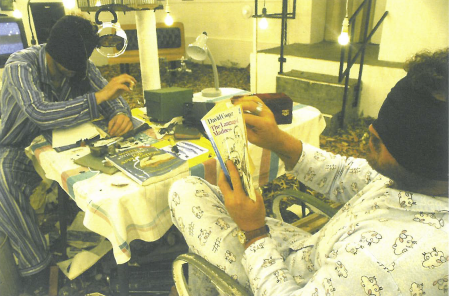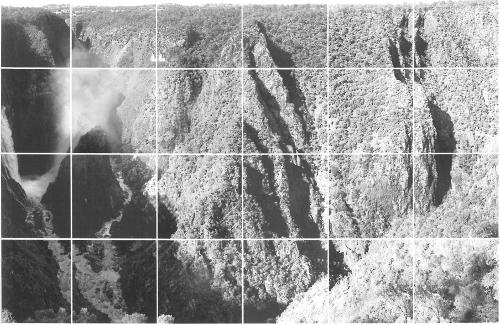
A collaborative pair, d&k is made up of emerging artists Dave Turley and Korin Gath. What is impressive about their developing practice is their total commitment to manifesting as fully as possible the core of what each project proposes; each time the germinating idea extends and multiplies and this unfolding stops only when money and time have run out. As a consequence the palpable energy emanating from the radically transformed spaces that they manipulate stretches the limitations we normally attribute to the phenomenological world, limitations that up until this point might have seemed inherently immutable.
Considering how the artists approach the performance of the installation process prior to inviting the audience into the gallery is for me one of the more interesting aspects of this exhibition, which incorporates installation, projection, sound and performance. The physicality of what is actually before me is not as clear as my imagining the process of its making: what components might have been omitted, how choices were arrived at and how hesitations, anxieties and contradictions were dealt with.
A few framed quotes placed within the installation underline the importance of cultivating a willingness to leap into the void without any guarantees of safe landings. Albert Camus proclaims: 'if the world were clear, we would not exist'; Nietzsche affirms that 'we have art to save ourselves from the truth', and Brecht warns us to 'not fear death so much as the inadequate life'.
d&k share with us the many questions that arise from these considerations, and then generously expose the process by which they conclude, perhaps temporarily, that any possible answer may be futile.
If you share with them the view that the darkness they envisage is manifesting around us, then a work like this can provide the brief flash of illumination that affords us, perhaps only for a split second, a view of the rhizome nature of a totality we normally perceive as fractured. In what we might call a d&k moment, the absence of dichotomies allows us to briefly perceive this totality as containing both cause and effect.
Through a three-hour opening performance, d&k attempted to unhinge cause from effect by dreamily engaging in a series of improvised blindfolded actions with hammers, smashing various objects and then re-arranging them endlessly, then reaching out for them again to reduce them to the smallest possible fragments, roughly equal in size to the thousands of tiny puzzle components dispersed through the floor of the gallery's front room.
The conundrum they present us with encourages us to ask whether what we see before us might be wholly itself, or a metaphor for further and more substantially veiled mysteries, or perhaps simultaneously both I and other, both subject and object.
This courageous embracing of paradox by artists such as d&k constitutes the primary quality that distinguishes for me art's more memorable moments, effortlessly sustained in time, from those that, lacking this tension, fade very quickly.
These lines from an essay titled The Nothingness of Personality (1922) by Jorge Luis Borges confront the paradox of appearance:
'Reality has no need of other realities to bolster it. There are no divinities hidden in the trees, nor any elusive thing-in-itself behind appearances, nor a mythological self that orders our actions. Life is truthful appearance. The senses do not deceive, it is the mind that deceives, said Goethe&'
Time must be taken to move around the darkness that d&k allude to, and time must be taken to peer into the paradoxes they provide us with as guides for the journey; there are rewards to be had.












